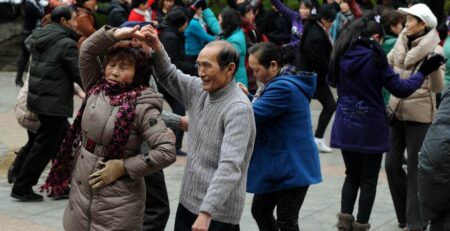The research aiming to keep people healthier for longer
Despite what the young might like to think, ageing is inevitable as adulthood progresses. In How We Age, geneticist Coleen Murphy provides no silver bullets for remaining youthful. Rather, she offers a scholarly account of the state of ageing research that is both lively and personal. She also gives real insight into the ups and downs of leading a research laboratory.
The book is a paean to the power of invertebrate model organisms such as the worm Caenorhabditis elegans and fruit fly Drosophila melanogaster, which are used often in biological experiments. These organisms are engines of discovery for neuroscience, genetics, immunology, metabolism — and ageing. Many findings from these species are applicable to vertebrate model organisms such as mice, as well as to humans.
One landmark discovery in the early 1990s was that a mutation in the C. elegans daf-2 gene allowed the worms to live more than twice as long as normal, as long as the daf-16 gene was active. In the following 20 or so years, it became clear that the daf-2 and daf-16 genes act together to safeguard the worm when conditions are harsh or food is scarce, by triggering an array of protective mechanisms. The daf-2 mutation prolongs life by turning up protective cellular processes such as protein ‘quality control’ and turning down harmful metabolic activity.
These results suggested that ageing is a malleable process, and thus could be targeted with drugs. How We Age focuses on the explosion of research that followed these discoveries.
In the early 2000s, genes related to daf-2 and daf-16 were shown to extend lifespan in both Drosophila and mice. And mutations in a human gene equivalent to daf-16 have been linked to longevity.
Murphy outlines a broad range of biological factors that can affect lifespan, including DNA damage and epigenetic modifications: molecular changes that affect gene expression without altering the DNA sequence. In youth, she explains, the expression of genes is tightly regulated. But these control mechanisms go wrong during ageing. Cellular constituents, especially proteins, can become too scarce or too abundant, which can stop the cell from functioning normally. Gene mutations that combat the effects of ageing, and lifestyle measures such as dietary intake, feed into these cellular processes. The wealth of biological detail on these and other processes related to ageing makes this book a valuable resource for people working in the field.
Persistence of memory
The author presents some fascinating evidence that ageing might be affected by ‘transgenerational inheritance’ — the idea that environmental effects, such as starvation and trauma, in one generation can have biological effects on many generations of offspring. As she notes, evidence for this phenomenon in mice and humans is intriguing, but largely correlational. Researchers in her lab have found that, when C. elegans is infected with the bacterium Pseudomonas, five generations of offspring will ‘remember’ the sickness caused by infection, and will avoid food that is contaminated with the bacterium.
The essence of the ‘memory’ seems to be small RNA molecules that the worm passes down, through its sperm and egg cells. These molecules somehow change the animals’ neuronal activity so that they avoid the bacterium. Such transgenerational transmission of stress could be important in ageing, Murphy proposes, and thus warrants further study.
Another captivating area of research is parabiosis, in which two animals share physiological systems. In the 1950s, US biologist Clive McCay and his colleagues stitched old and young rats together at the skin, giving them a common blood circulation. The experimenters noticed signs that the cartilage of the old rats had become healthier. Since then, parabiosis experiments in mice have revealed that ‘young’ blood can rejuvenate the ageing body. Evidence is mounting that molecules in the serum of young blood somehow boost stem-cell function, helping stem cells to repair old and damaged tissue. Some of these rejuvenating serum molecules are now known; a cocktail of them might provide a way to maintain cognitive function and avoid dementia as people age, Murphy explains.
The author is thoughtful when discussing the ethics of research into ageing. The huge increase in human life expectancy since the mid-nineteenth century, from around 40 years to more than 80 in many countries today, is to be celebrated, she notes. Better living conditions and medical care have improved people’s health at all ages in most parts of the world. But people are spending more years near the end of their life experiencing ill health — an estimated 16 years for men and 19 years for women in the United Kingdom, for instance.
Perhaps medical interventions could help. But Murphy is at pains to point out that poor health during ageing is often a result of socio-economic disadvantage, and that equitable access to any anti-ageing intervention is essential — especially because such interventions might have the greatest benefits for the most disadvantaged people.
In her own lab, Murphy is aiming to find ways to compress the period of ill health at the end of peoples’ lives. Research in animals might hold clues to how to achieve this. For instance, worms with the mutated daf-2 gene retain their ability to move, learn and remember smells and tastes, well into old age. And restricting the diets of mice by about 40% from early adulthood onwards increases the average age at which mice begin to show signs of ill health.
Towards the end of the book, Murphy moves from basic to clinical research. Super-rich individuals and biotechnology companies are investing heavily in medicines to prevent the ills of ageing. As the author says, some approaches are on a sounder footing than others.
A healthy mix of microbes in the gut and skin might be important for health during ageing. However, Murphy points out that the evidence for this idea is almost entirely correlational, despite the numerous products already on the market that claim to boost health by altering gut flora.
By contrast, clinical trials of drugs that combat the effects of harmful senescent cells, which accumulate with age, are starting to show some promise, for instance by increasing walking speed for people with the ageing-associated lung disorder idiopathic pulmonary fibrosis.
Finally, although dietary restriction is effective in animals, humans have struggled to follow regimented diets in clinical trials. The idea of capturing the benefits of dietary restriction — or of exercise — with a drug is gaining traction. The molecular mechanisms that make diet and exercise beneficial are increasingly better understood, and some are the targets of existing drugs. Researchers hope to repurpose these drugs to capture some of the benefits of a healthy lifestyle.
How We Age will be particularly useful to researchers, but it should also appeal to general readers who want to know what it took to arrive at the current understanding of ageing — and the prospects of undergoing it in better shape.
Read more @nature











